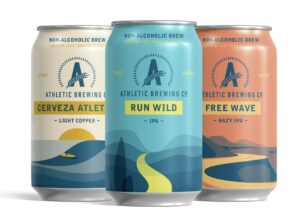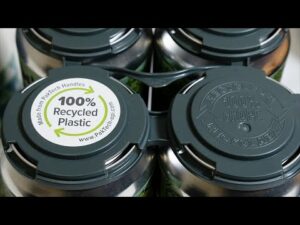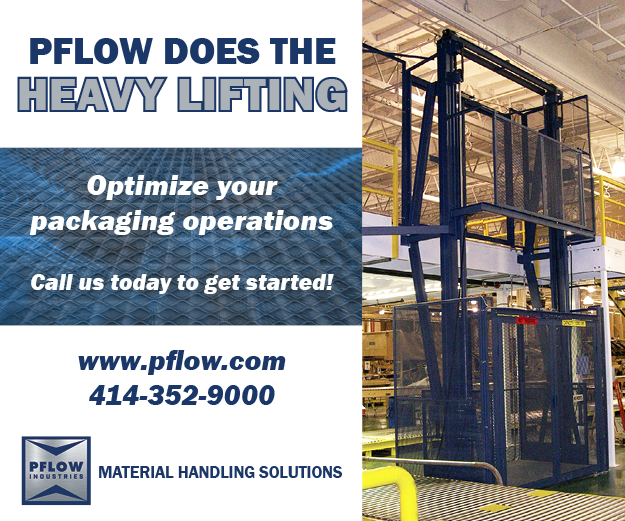Top Trends Impacting Craft Beer Packaging
Package Design Earns a Place for Beverages in Consumers’ Hands and Hearts
By Moira Stein, Insights & Strategy at Berlin Packaging

Berlin Packaging supplies cans for Athletic Brewing, a leader in the non-alcoholic craft beer category. Image Courtesy of Berlin Packaging
Ales, lagers, porters, stouts, pilsners, IPAs, and more. There are over 100 distinct styles of beer. Some are light and malty while others are strong and hoppy. Each has its distinctive taste, scent, color, and character. And there are over 10,000 craft breweries in the United States with unique stories and personalities all their own.
With so much competition from small breweries and big brands alike, packaging plays a critical role in establishing a brand identity, standing out from the competition, and earning a place in the hands and hearts of consumers. Understanding the latest consumer insights, product trends, and packaging innovation is essential in crafting the perfect package for your craft beer brand. Here are some of the key trends influencing beer package design in 2023.
Moderation
From Dry January to Sober October, the moderation movement has been brewing for several years, and consumers’ journey toward more mindful drinking is here to stay. The shift toward healthier lifestyles and changing attitudes about alcohol (especially among younger consumers) is cementing no/low alcohol beer and other beverages as a lasting trend rather than a passing fad.
The old notions of what non-alcoholic beer looks and tastes like are changing. Broader availability, increased marketing support, product innovation, improved taste credentials, and rising consumer engagement are driving opportunities for low-ABV craft beers. Expect more diverse offerings, premium products, and functional benefits entering the category.
So, what does this mean for packaging? While consumers are interested in no/low alcohol beer, they don’t want to sacrifice the beer-drinking experience. Package design should maintain a brand’s visual equity elements and personality and look like traditional beer. These are still beers, after all. They just happen to have no/low alcohol content.
The packaging needs to differentiate with clear communication about the benefits and attributes of these products, but it still needs to live up to expectations for an enjoyable beer occasion. Emphasizing quality ingredients, brewing methods, and taste credentials can reassure consumers that these products are just as satisfying as their ABV counterparts.
Price Polarization
Record-setting inflation, rising prices, and budget concerns are driving consumers to be more value-conscious. Many consider beer an affordable luxury and will continue to treat themselves while considering other factors, including quality and value. Polarization – encapsulating the opposing forces of premiumization and economizing – will become a driving factor in the category. While premiumization will remain, there will likely be a slowdown due to economic uncertainty, and creating value for consumers will become increasingly important.
When it comes to packaging, this includes offering alternative sizes. Smaller cans and bottles are entering the market, providing consumers with their favorite beers at a lower price point.
Conversely, larger packs like 18-counts can provide a better price-per-unit. Beyond pack size, brand design plays a role in the value equation. Effective and impactful design that communicates quality and taste and promises a positive user experience can reassure consumers that a brand is worth the price.

Berlin Packaging repurposed 4,594,504 recycled containers by choosing PakTech handles in 2022. Image courtesy of Berlin Packaging.
Flavor Innovation
Today’s consumers are looking for more exciting and unique experiences following the stress and monotony of the pandemic. They want to try new things and are more adventurous in what they eat and drink. There has been a spike in exotic ingredients, unexpected flavors, and interesting flavor combinations across alcoholic beverage categories.
Ready-to-drink beverages and hard seltzers have stolen share from beer in part because they appeal to consumers with flavor. Craft beer brands can capitalize on this trend with innovative blends that appeal to consumers seeking these flavorful experiences. Package design with fun graphics aligns nicely with the demand for more enjoyable, adventurous, and interesting experiences. This includes using bright colors, playful elements, and retro references, which are especially on-trend this year.
Sustainability
Today’s consumers demand sustainability, and brands can show their commitment to the environment through responsible ingredient sourcing, efficient production methods, and eco-friendly packaging solutions. In the beer category, cans are gaining share from glass bottles in part due to their sustainability credentials. Aluminum has a high recyclability rate and is lighter weight than glass. The craft beer movement helped end the perception that glass is more premium, making cans even more appealing for brands. Beyond the growth of cans, innovations are happening in the category, such as biodegradable and post-consumer recycled six-pack rings, paper bottles, and cardboard containers.
About the Author
Moira Stein leads Insights & Strategy at Berlin Packaging. She has spent 20+ years working in brand marketing, with a focus on strategy and design. For the past three years, she has helped Berlin Packaging’s customers leverage consumer and category insights to develop strategic package design solutions that create impact and drive sales. Moira has experience across a variety of sectors, including food & beverage, personal care, and home care. Her clients have included large CPG companies like SC Johnson, Kraft, and ConAgra Foods, as well as small distilleries, wineries, craft breweries, and start-ups. Learn more at https://www.berlinpackaging.com/







